 Cannon, manufacturer of gas cookers, catalogue cover 1920s
Cannon, manufacturer of gas cookers, catalogue cover 1920s Cannon Challenge gas cooker, 1920s
Cannon Challenge gas cooker, 1920s Cooker advertisement, County Express, Jan 9th 1937
Cooker advertisement, County Express, Jan 9th 1937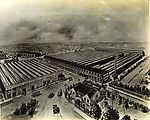 Bird's eye view of the Revo factory in Tipton in the 1920s
Bird's eye view of the Revo factory in Tipton in the 1920s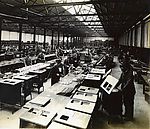 Revo cooker assembly bay
Revo cooker assembly bay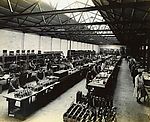 Revo electric fires and irons bay
Revo electric fires and irons bay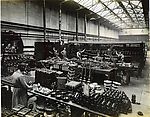 Revo stove enamelling bay
Revo stove enamelling bay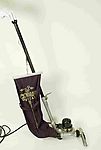 Goblin Wizard electric vacuum 1930s (held at the Black Country Living Museum)
Goblin Wizard electric vacuum 1930s (held at the Black Country Living Museum) Gas iron, Arden Hill Company (held at the Black Country Living Museum)
Gas iron, Arden Hill Company (held at the Black Country Living Museum) 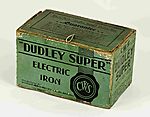 Electric iron box, Cooperative Wholesale Society (held at the Black Country Living Museum)
Electric iron box, Cooperative Wholesale Society (held at the Black Country Living Museum) Singer sewing machine, 1870 (held at the Black Country Living Museum)
Singer sewing machine, 1870 (held at the Black Country Living Museum)

"Simply switch on" - that was the difference between the old way of doing things in the home and the new. The phrase appeared in almost every instruction leaflet for electrical goods from the 1920s to the 1950s. An investment in a new piece of electrical gadgetry promised an escape from the old domestic chores.
It should be remembered, however, that between the two world wars most people continued to do their housework by hand.
Before electricity, the most advanced machines in the home, the sewing machine, carpet sweeper and mangle were all hand-operated. The hub of the late-Victorian home was the coal-fired range, but it was dirty, temperamental and took time to use and to clean. Easy-to-clean gas and electric enamel cookers only started to become popular after the First World War.
The washing was done by hand.Clothes were boiled in a large copper cauldron and pounded with a "dolly", rubbed on a washboard, wrung out through a mangle and then ironed using flat irons heated on the range. It took a long time and was exhausting work. Any family that had enough money to do so would send out their laundry to be done professionally. Domestic washing machines were not cheap enough for most people to buy until the 1950s.
Dust was the great enemy of the Victorian home, but the wide variety of brushes designed to deal with the problem did little more than stir it up, only to settle later elsewhere. It was W.H. Hoover who developed the first portable vacuum cleaner, suitable for domestic use, in 1908. "The Electric Suction Sweeper" became popular in America almost immediately, but progress in Britain was slower.
Electricity was not readily available in most homes until after the First World War. The demand for domestic electrical goods began to rise in the 1920s. By 1939 the market for smaller, cheaper appliances had grown significantly. A major manufacturer at this time was the Revo Company, based in Tipton in the Black Country.
There were a number of reasons for the growth of demand:-
Homes built during the housing boom of the inter-war years were all wired for electricity.
The supply of electricity became standardised and more reliable with the setting up of the National Grid between 1928 and 1935.
The cost of electrical goods fell during the 1920s and 1930s as the British electrical appliance industry grew.
The new hire-purchase system meant that the cost of an electrical appliance could be spread over a long period.
Electrical goods were promoted by the Electrical Development Association and the Electrical Association for Women, and were widely available through door-to-door sales, local bicycle, hardware and ironmongery stores, in town department stores and from local electricity board showrooms.
Rollover the captions in the box to see the available images in thumbnail format, click the caption to see the full-size image
| Reference: | 750 |
| Keywords: | |
| Archive Ref: | See metadata |
| Updated: | Wed 23 Apr 2008 - 0 |
| Interpretation written by | Barbara Harris |
| Author's organisation | |
| Organisation's website |